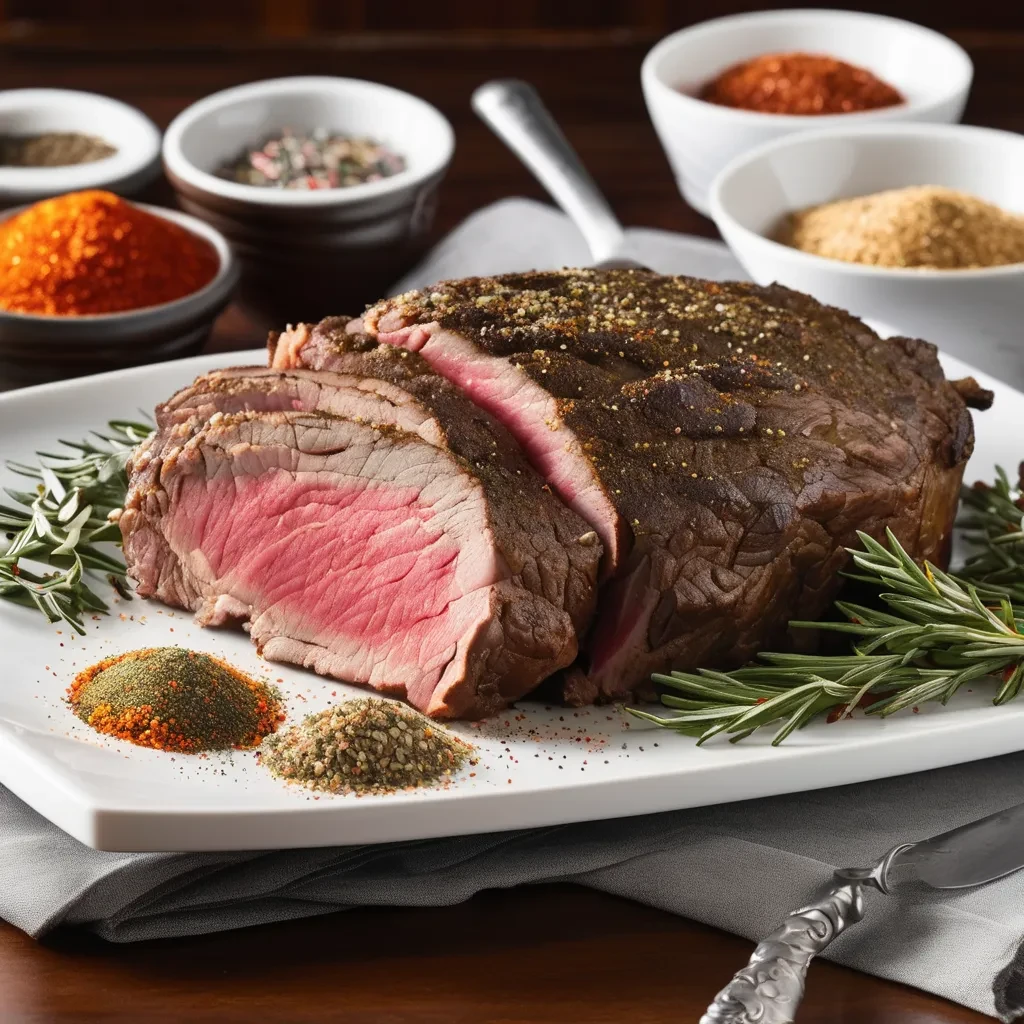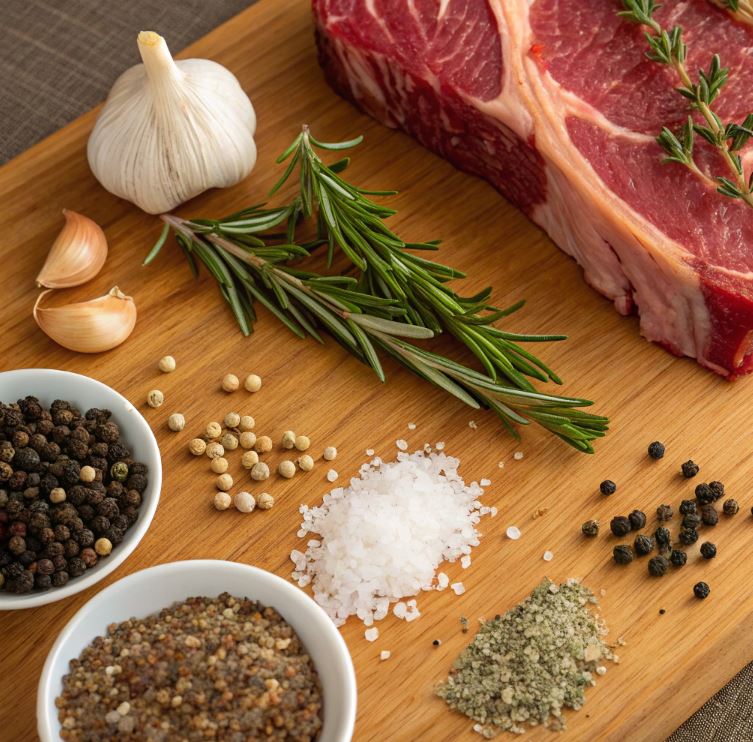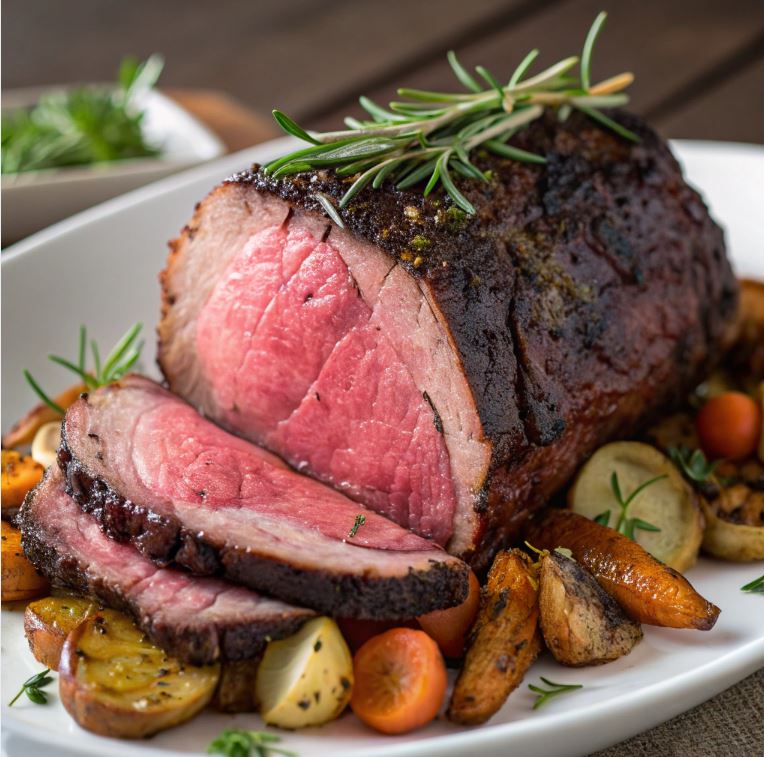When it comes to creating an unforgettable roast, the key to success is using the right prime rib seasoning recipe. The seasoning enhances the beef’s natural flavors, creating a savory crust that locks in the juices and provides an irresistible texture. A well-balanced prime rib seasoning recipe turns a quality cut of meat into an extraordinary culinary experience.
Whether you’re preparing for a holiday feast or a special family dinner, this guide will help you master the perfect prime rib seasoning recipe.

Understanding the Importance of Seasoning in Prime Rib
The Foundation of Flavor
Seasoning is not merely an afterthought when preparing prime rib. It serves as the foundation for flavor, enhancing the natural taste of the beef while creating a savory crust that seals in the juices.
Why It Matters
Proper seasoning ensures that every bite is packed with flavor, balancing the richness of the meat with complementary aromas and tastes. Whether you’re preparing for a holiday feast or a special dinner, the right seasoning makes all the difference.
Key Ingredients for a Prime Rib Seasoning Recipe
Essential Components
Creating the perfect prime rib seasoning starts with selecting the right ingredients. While every recipe can vary based on personal preferences, there are several essential components that ensure a balanced flavor:

- Salt: The cornerstone of any seasoning mix. It enhances flavor and helps tenderize the meat.
- Pepper: Freshly cracked black pepper adds a touch of heat and complexity.
- Garlic Powder: A must-have for its robust and savory notes.
- Herbs: Rosemary, thyme, and parsley are classic choices that pair beautifully with beef.
- Spices: Paprika adds a hint of smokiness, while cayenne pepper delivers a subtle kick.
- Olive Oil or Butter: These act as a base to help the seasoning adhere to the meat.
Step-by-Step Guide to Making the Perfect Prime Rib Seasoning
Craft Your Seasoning Blend
Follow these steps to create a foolproof prime rib seasoning:
- Gather Your Ingredients: Measure out your salt, pepper, garlic powder, and other desired spices.
- Combine the Ingredients: Mix them in a bowl until evenly blended.
- Add Fresh Herbs: Chop fresh rosemary and thyme for added freshness.
- Incorporate a Base: Stir in olive oil or softened butter to form a paste if you prefer a wet rub.
- Taste Test: Adjust the ratios to suit your preferences, ensuring the flavors are balanced.
How to Apply Seasoning to Prime Rib for Maximum Flavor
Steps for Perfect Application
Applying the seasoning correctly is as important as the ingredients themselves. To maximize the flavor of your prime rib, follow these tips:
- Pat the Meat Dry: Use a paper towel to remove excess moisture for better seasoning adherence.
- Generously Coat the Surface: Rub the seasoning mix all over the meat, ensuring even coverage.
- Let It Rest: Allow the seasoned prime rib to rest for at least an hour, or overnight in the refrigerator for deeper flavor penetration.
- Room Temperature Before Cooking: Bring the meat to room temperature before cooking to ensure even cooking.
Dry Rub vs. Wet Marinade: Which is Better for Prime Rib?
Pros and Cons of Each Method
- Dry Rub: Provides a flavorful crust when roasted, ideal for traditional, robust flavors, and easier to prepare.
- Wet Marinade: Penetrates deeper into the meat, adds moisture, and requires additional time for marinating.
Best Herbs and Spices for a Signature Prime Rib Seasoning
Herb and Spice Combinations
The right combination of herbs and spices can elevate your prime rib seasoning to a whole new level:
- Herbs: Fresh rosemary, thyme, and sage offer earthy and aromatic flavors.
- Spices: Paprika for a smoky note, cayenne for heat, and mustard powder for tanginess.
- Enhancers: Garlic and onion powder add depth, while lemon zest brightens the overall flavor profile.
The Role of Salt in Enhancing Prime Rib Flavor
Why Salt is Essential
Salt is arguably the most important ingredient in any prime rib seasoning recipe. Beyond its basic seasoning properties, salt works as a tenderizer and enhances the natural flavors of the meat:
- Tenderizing Effect: Salt breaks down muscle proteins, resulting in a tender texture.
- Flavor Enhancement: It amplifies the beef’s natural umami notes.
- Crust Formation: Salt contributes to the development of a savory crust during roasting.
Common Mistakes to Avoid When Seasoning Prime Rib
Avoid These Pitfalls
Seasoning prime rib may seem straightforward, but even seasoned cooks can fall into common traps:
- Underseasoning the Meat: Prime rib is a thick cut, and inadequate seasoning can leave it tasting bland.
- Skipping Rest Time: Letting the meat rest after seasoning allows the flavors to meld with the beef.
- Uneven Application: Failing to coat the meat evenly results in inconsistent flavor.
- Using Fine Salt: Opt for coarse kosher or sea salt for better results.
- Adding Salt Too Early with Wet Marinades: Adding salt too early can draw moisture out of the meat, drying it out.
Prime Rib Seasoning Tips for Various Cooking Methods
Adapting Seasoning for Every Style
- Oven Roasting: Use a dry rub for a beautifully caramelized crust.
- Grilling: Incorporate smoky spices like paprika and chipotle powder for a grilled flavor.
- Sous Vide: Focus on salt and garlic to enhance the natural flavors during cooking.
- Smoker: Use a rub with brown sugar for a subtle sweetness that complements smoky flavors.
Seasoning Variations for Different Palates
Customize Your Blend
- Classic Herb Blend: A mix of rosemary, thyme, garlic, and black pepper.
- Spicy Kick: Add cayenne pepper, smoked paprika, and chili flakes.
- Savory Umami: Incorporate soy sauce powder or miso paste.
- Sweet and Smoky: Use brown sugar, cinnamon, and smoked paprika.
- Mediterranean Flair: Combine oregano, lemon zest, and a touch of cumin.
Pairing Your Prime Rib with Complementary Sides
Side Dish Recommendations
A perfectly seasoned prime rib deserves equally delicious side dishes:
- Potatoes: Creamy mashed potatoes or crispy roasted potatoes with rosemary.
- Vegetables: Sautéed green beans, roasted asparagus, or caramelized Brussels sprouts.
- Grains: Herbed wild rice or creamy risotto.
- Salads: A crisp Caesar salad or an arugula salad with lemon vinaigrette.
- Bread: Serve warm dinner rolls or a crusty baguette.
Conclusion: Elevating Your Prime Rib with the Perfect Seasoning
Mastering prime rib seasoning is the key to transforming an excellent cut of meat into an unforgettable centerpiece. By pairing your perfectly seasoned prime rib with complementary sides and avoiding common mistakes, you’ll create a culinary triumph that leaves your guests eagerly awaiting their next bite.

